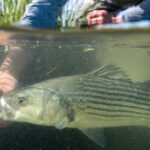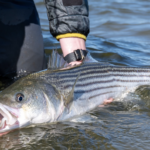
Better Data for Bluefish: Get Involved!
Feature Photo: Mike Querfeld with a low-light shot of a yellow-eyed devil before the release.
With everything that’s going on with striped bass right now, it’s easy to forget the ugly stepchild. But bluefish need some attention right now, because if abundance keeps trending downward, we’ll all be in some trouble.
Across its range, bluefish have been uncharacteristically sparse during the last several years. And that isn’t good, because we all know about the striper fishing. While most of us have experienced some periods of good fishing over this year and last, from a consistency and “usual-haunts” perspective, let’s be honest, it ain’t good. The truth is, more and more, a lot of us have come to depend on bluefish to a much greater extent than we used to.
And that’s not a terrible thing, because bluefish are awesome. While they may not be as handsome as a striped bass, for sure they make up for it in sheer violence. And it’s very cool when those 15-pounders get into that real skinny stuff and tail like a bonefish or daisy-chain like a school of tarpon. Even the small ones have made a day, more times than I’d like to admit. I think you get the point. The bluefish fishery is REALLY important. Not just to the light tackle folks but to tackle manufacturers that sell lots more gear when these tackle destroying brutes show up.
But a recently released operational stock assessment says what most of us already suspected. Bluefish, like striped bass are overfished. Interestingly enough though, “overfishing” isn’t occurring, or at least it wasn’t occurring in 2018. The new recalibrated data in the assessment indicates that while we had actually been overfishing for quite some time, in 2018, likely because of the lack of availability, we dipped below the fishing mortality target for the first time in a long time.
So what the hell happened?
There are certainly those folks who say bluefish are all just offshore, even though there’s no science that I’m aware of that would suggest that’s the case. And being someone who spends a good three months of the year running offshore, and someone who is tied into offshore fleets both to the north and south, I can say – anecdotally of course – there certainly doesn’t appear to be an aggregation of bluefish out there. That said, I would note, again anecdotally, that bluefish do indeed appear to show definitive, inexplicable swings in abundance. During some years it’s hard to stay away from them.
Are we or were we overfishing them? Well certainly the science shows that’s the case, but it doesn’t really matter. When the stock trends downward like this we should be reducing fishing mortality on them. Less fish, less pressure. That only makes sense if you want them to come back.
Council vs. Commission
It’s important to make the distinction here that bluefish are managed by a federal Council (the Mid Atlantic Fishery Management Council) whereas striped bass are managed by the a compact of states – the Atlantic States Marine Fisheries Commission.
Federal law – The Magnuson Stevens Fishery Conservation and Management Act – requires that should a stock become overfished, the Council HAS to address it. For one, that means that the Mid Atlantic Fishery Management Council will have to constrain bluefish landings in 2020. How the Council and Commission chose to do that will be determined in December after the Commission and Council receive recommendations from staff.
We see no need for the current 15 fish bag limit that currently exists. Yes, there are some folks who strive to keep that many, and some businesses that promote “limiting out” on bluefish, but the reality is that most the recreational fishing community keep few bluefish, if any. But we’re not at a place where we can even really discuss that yet. We’ll have a pretty good idea of what the recreational management measures might be in late Nov, early December. It’s entirely possible, in fact likely that there will be some seasonal constraints discussed. And I wouldn’t doubt if there was a “sector separation” proposal put on the table (i.e. different regs for charter/party and anglers). More on this in December.
Moving on, that “overfished” designation with bluefish also means something else. The Magnuson Act requires that should a stock become overfished, a rebuilding plan must be implemented within two years of such finding.
Without getting too much into the weeds here, not only does bluefish need to be rebuilt so that the spawning stock biomass is over the threshold, it needs to be rebuilt to a “target” biomass that is quite a bit over that. Therefore, such a rebuilding plan will likely result in constraining the fishery two years from now significantly more than the Council will constrain it in 2020.
That is not the case with something like striped bass. To their credit, the Commission did initiate an amendment to address overfishing, but because they do not have a mandate to initiate a rebuilding plan, well, when the striped bass stock became overfished, they didn’t. They may, moving forward, but they also may just decide to lower the bar on what a healthy stock looks like, so they don’t have to. Frankly, I think that’s the most likely case.
The truth is that the political pressure to avoid decisions that may be unpopular with certain sectors, and to adopt half-measures instead, is too great at the Commission. With something under federal management, like bluefish, the council is somewhat isolated from such political pressure and the resultant half-measures. Because the law says that it HAS to address overfishing, and is HAS to rebuild.
For sure, some folks look at the bluefish situation as punitive, and believe Councils should have the flexibility to avoid constraining measures, because “the fish are all just offshore”, or that swings in abundance are just cyclical. But having had enough experience in the management world to know the following to be true, that sort of flexibility would allow the councils to avoid overfishing and rebuilding all together. We can certainly argue here that being isolated from political pressure is a good thing.
All this said, we do not disagree that the Councils have some work do to in how they manage recovered stocks. Particularly black seabass and scup, which are both well over their biomass targets, creating a situation where anglers overfish simply because there are a lot of them around. And they are indeed working to figure out “creative” solutions to such problems. That sort of flexibility/problem solving ability already exists under current law.
But how the council is addressing bluefish is a real good example of how federal law works to keep a few fish in the water for folks like us that need ’em to stay in business. It would be nice to see that kind of thing with striped bass, but hey, that aint’ gonna happen.
Bluefish Allocation Amendment
It’s also important to note here that the council is also moving forward with work on its Bluefish Allocation Amendment. The intent here’s to revisit commercial/recreational allocations, state allocations, and the current quota transfer process where unused recreational quota is transferred to the commercial sector.
This could have been VERY problematic for the recreational community, as we stood to lose much of our 83% allocation. Before the recalibration of recreational landings used in the operational assessment, it looked like we hadn’t been using near our full share. Because of a provision in the management plan, that meant that we’d always transfer much of that unused quota to the commercial sector, making the whole catch-and-release for conservation reasons idea moot.
There were certainly some folks on the Council who believed we should just permanently reallocate those “unused” fish to the commercial sector, through the pending amendment. That would have been bad, because it completely dismisses the idea that managing for live bluefish in the water was just as important, and perhaps more so, than managing only for harvest.
However, due to the new, increased catch and effort estimates resulting from the MRIP recalibration, it’s clear that anglers have actually fully utilized their quota for pretty much every year in the time series. Thus, there is really no basis for a reallocation of quota.
We should also note that, as a result of the initial scoping process for the amendment, and comments from our industry, the Council is fully aware of the value of fish in the water, not simply those harvested, and that abundance and availability to the recreational community is economically significant.
Takeaways
Wrapping it all up here, yes, bluefish are important. Really important. Not just dead ones, but live ones swimming around in the water.
Bluefish is perhaps the best illustration of the value of keeping a few fish in the water, as a large component of this fishery is catch-and-release, not simply for conservation reasons but because they don’t keep well, and are considered by many to be of poor eating quality. For the same reasons they don’t draw a high price for commercial folks either.
For us, having an abundance of these fish, in the water, drives opportunity and effort, as it helps us book trips, and sells tackle. There is undoubtedly real economic value to leaving fish in the water in this case. And we would argue they are actually worth more alive than dead.
We certainly aren’t advocating a no-kill fishery here, or even a shift in quota from commercial to recreational. But what we do want to see is an acknowledged value of leaving those fish in the water available to anglers. In that respect both the Council and Commission appear to be coming around.
Unequivocally there are less bluefish around these days. Why that’s happened isn’t relevant in our opinion. What is relevant is when there’s a stock decline such as this one, we reduce harvest, which is just common sense. And we keep pressure low until we get that stock back up to a healthy and sustainable level.
While, unfortunately this is not so much the case with state managed fish like striped bass, with federally managed fish like bluefish, the Magnuson Act requires that we do that.
And THAT is a good thing.

Feature Photo: Mike Querfeld with a low-light shot of a yellow-eyed devil before the release.

The Atlantic States Marine Fisheries Commission (ASFMC) will gather in Arlington, Virginia this week for the

Consistent spawning production is paramount to a fishery’s long-term health. Many environmental factors are suspected

While the ASGA team is extremely proud of the community we’re building with the Guide
We rely on our members and donations to keep fighting for a sustainable tomorrow in marine conservation.
By using this website, you agree to our use of cookies. We use cookies to provide you with a great experience and to help our website run effectively. To learn more, please review our privacy policy.
2 Responses
I think the limit should should be knocked to 10 fish.